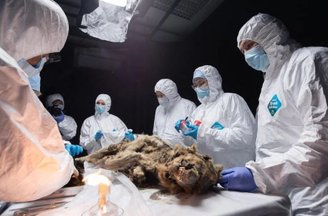A team of researchers A fully mummified wolf species was discovered near a river in the Sakha Republic, in a region of Siberia. The animal appears to be 44,000 years old and was dug out of permafrost, a layer of permanently frozen soil commonly found in Arctic regions where soil temperatures remain below 0 degrees Celsius.
The species was discovered in the permafrost of the Tirekhtyakh River in eastern Russia, about 40 meters below the surface. The most impressive thing is that the wolf’s body is quite preserved.; was transferred to the Academy of Sciences of the Sakha Republic, where scientists from different universities performed an autopsy.
During the analysis, the researchers collected samples of organs and contents stored in the wolf’s digestive system. The team believes the species may contain living bacteria, as it is not uncommon for bacteria to survive in fossils for thousands of years. But they are still examining samples to see if the mummified animal contains any bacteria.
“His stomach is kept in isolation, there are no contaminants, so the task is not trivial. As a result of the preparations, we hope to obtain a snapshot of the ancient Pleistocene biota. It was an active and large predator, we have the opportunity to discover what it ate. Moreover, the objects consumed by its victims also reached its stomach,” he said in Sciences Albert Protopopov, head of the Academy’s mammoth fauna research department.
Mummified worm and live bacteria
Permafrost is a frozen subsoil layer that provides ideal conditions for preserving animal bodies, as its cold, dry conditions allow soft tissues to dry and mummify.
Initial analysis suggests that the wolf was a large and active male; the food contents of its victims were also in its stomach. In addition to bacteria, scientists are also looking for certain types of viruses that can survive in harsh conditions.

Due to sub-zero temperatures, possible bacteria, viruses and other microorganisms on the animal may be dormant. The aim of the researchers is to use these bacteria in the field of modern biomedicine.
“We hope to get good results that will allow us to go a little further in understanding what ancient microbial communities were, what function they performed and to what extent dangerous pathogenic bacteria were represented in their structure. Perhaps microorganisms will be discovered that can be used as promising producers of biologically active substances in medicine and biotechnology,” said Artemy Goncharov, Professor of the Department of Epidemiology, Parasitology and Disinfection of the North-West State Medical University.
Did you like the content? So, stay up to date with more science news here on TecMundo. Or take the opportunity to understand how the Earth snowballed 717 million years ago.
Source: Tec Mundo
I’m Blaine Morgan, an experienced journalist and writer with over 8 years of experience in the tech industry. My expertise lies in writing about technology news and trends, covering everything from cutting-edge gadgets to emerging software developments. I’ve written for several leading publications including Gadget Onus where I am an author.













